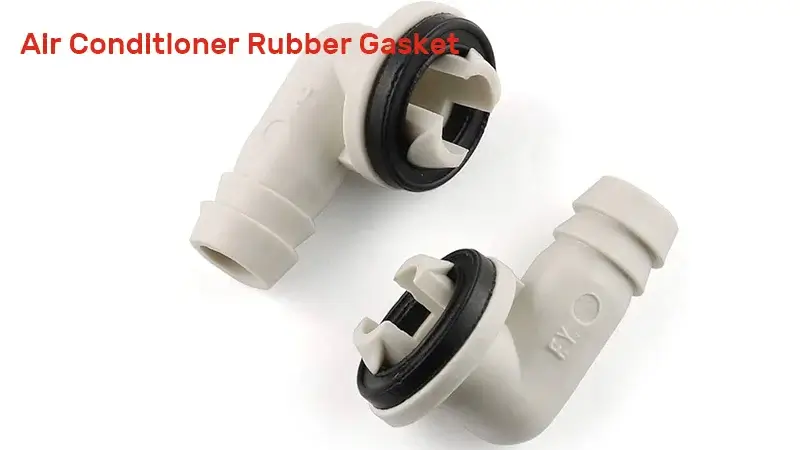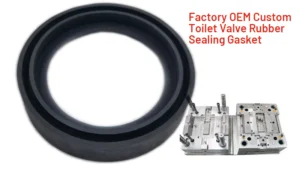The air conditioner rubber gasket is a crucial component designed to ensure a tight seal between the air conditioning unit and its mounting surface, preventing leaks and enhancing overall efficiency. In this post, we will introduce the rubber gasket for air conditioner’s performance characteristics and types.
Air Conditioner Rubber Gasket Performance Characteristics
The AC rubber gasket serves as a vital sealing material designed specifically for air conditioning outlets. Typically made from high-quality rubber, this gasket plays a crucial role in preventing air leaks from the outlet, thereby ensuring the efficiency of the entire air conditioning system.
The rubber gasket boasts several performance characteristics that enhance its functionality and longevity:
Excellent Shock Absorption: The rubber gasket is engineered to provide superior shock-absorbing capabilities, effectively dampening vibrations and minimizing noise. This feature contributes to a quieter operational environment, enhancing overall comfort.
High Adhesion Properties: With strong adhesive qualities, the gasket securely adheres to the surface of the air outlet, ensuring a tight seal that prevents air leakage. This reliable adhesion is crucial for maintaining system efficiency.
Durability Against Aging: The rubber material exhibits excellent resistance to aging, allowing it to withstand various environmental, temperature, and climatic conditions over extended periods. This durability ensures consistent performance without degradation.
High-Temperature Resistance: Designed to operate effectively at elevated temperatures, the gasket maintains its shape and functionality without warping or damage, making it suitable for diverse operating conditions.
Effective Sealing Performance: The gasket’s design ensures a robust seal that significantly reduces air leakage, thereby improving the overall efficiency of the air conditioning system. This characteristic is essential for energy conservation and optimal cooling performance.
Ease of Installation and Replacement: The gasket is designed for straightforward installation and replacement processes, allowing for quick and efficient setup. This ease of use enhances productivity during maintenance tasks.
How to Improve the Service Life of Rubber Gaskets?
As we all know, the living environment of rubber gaskets is very harsh, and the damage to rubber is serious, so how can we improve the service life of rubber gaskets?
If we want to improve their service life, we must improve their performance. The different uses of rubber gaskets determine the different performances of rubber gaskets. In general, we need to improve the rubber gasket air tightness, compressibility, creep resistance, chemical corrosion resistance, resilience, adhesion resistance, non-corrosiveness, and temperature resistance. With improved performance and quality, its service life will naturally increase.
Air Conditioner Rubber Gasket Maintenance Tips
To ensure the longevity and optimal performance of your rubber gaskets, consider the following maintenance tips:
Regular Inspections: Periodically check the gaskets for signs of wear, such as cracks, deformation, or brittleness. Inspecting them every six months can help identify potential issues before they lead to significant problems.
Cleanliness: Keep the gasket surfaces clean and free from debris. Use a soft cloth and mild detergent to wipe down the areas where the gasket makes contact, ensuring a proper seal.
Proper Installation: Ensure that gaskets are installed according to manufacturer guidelines. Over-tightening or misalignment can lead to premature wear.
Environmental Considerations: Protect gaskets from extreme temperatures and harsh chemicals whenever possible. If your application exposes the gasket to such conditions, consider using materials specifically designed for those environments.
Replacement Timing: Replace gaskets at the first sign of significant wear or damage. It’s advisable to check gaskets annually for air conditioning systems, especially before peak usage seasons.
Common Rubber Gasket Types
Rubber sealing gaskets are essential components used in various applications, and several types are commonly utilized, including silicone gaskets, nitrile rubber gaskets, fluororubber gaskets, and other specialty rubber gaskets.
1. Silicone Gaskets
Silicone gaskets are renowned for their exceptional temperature resistance, maintaining flexibility in a wide range from -70°C to 260°C. They exhibit excellent resistance to ozone and weather aging, making them suitable for sealing applications in thermal machinery. Additionally, they are non-toxic and can be used to create insulating and medical rubber products. Silicone gaskets also possess outstanding properties such as waterproofing, flame resistance, high-temperature tolerance, conductivity, wear resistance, and oil resistance. These features make them widely applicable across industries such as machinery, electronics, and plumbing. Our silicone gaskets comply with EU environmental standards and food-grade regulations.
2. Nitrile Rubber Gaskets (NBR)
Nitrile rubber gaskets are made from a copolymer of butadiene and acrylonitrile. They are well-known for their excellent oil resistance and also offer good abrasion resistance, aging stability, and airtightness. These characteristics make nitrile gaskets widely used in the rubber industry. They can withstand temperatures ranging from -20°C to 110°C and pressures of up to 16 MPa.
3. Fluororubber Gaskets
Fluororubber gaskets are designed to withstand high temperatures and can operate effectively in environments ranging from -20°C to +200°C. They exhibit excellent resistance to strong oxidizers, oils, acids, and alkalis. These properties make them ideal for use in high-temperature, vacuum, and high-pressure applications, particularly in the petroleum industry.
4. Other Rubber Gaskets
This category includes neoprene, natural rubber, ethylene propylene diene monomer (EPDM), ester-based rubber, and other specialty rubbers. These materials provide a variety of benefits such as oil resistance, acid and alkali resistance, wear resistance, and the ability to withstand extreme temperatures.
- Natural Rubber Gasket: Operates effectively between -50°C to 80°C with pressures up to 16 MPa.
- Neoprene Gasket: Suitable for temperatures from -20°C to 100°C with pressures up to 16 MPa.
- EPDM Gasket: Functions within -57°C to 176°C at pressures greater than 2.5 MPa.
- Silicone Gasket: Capable of withstanding temperatures from -100°C to 300°C with pressures exceeding 3.0 MPa.
Custom Air Conditioner Rubber Gasket from Us
Ready to enhance your air conditioning system with our high-quality rubber gaskets? Don’t wait until leaks become a problem! Visit our website to explore our range of rubber gaskets tailored for air conditioning systems.






